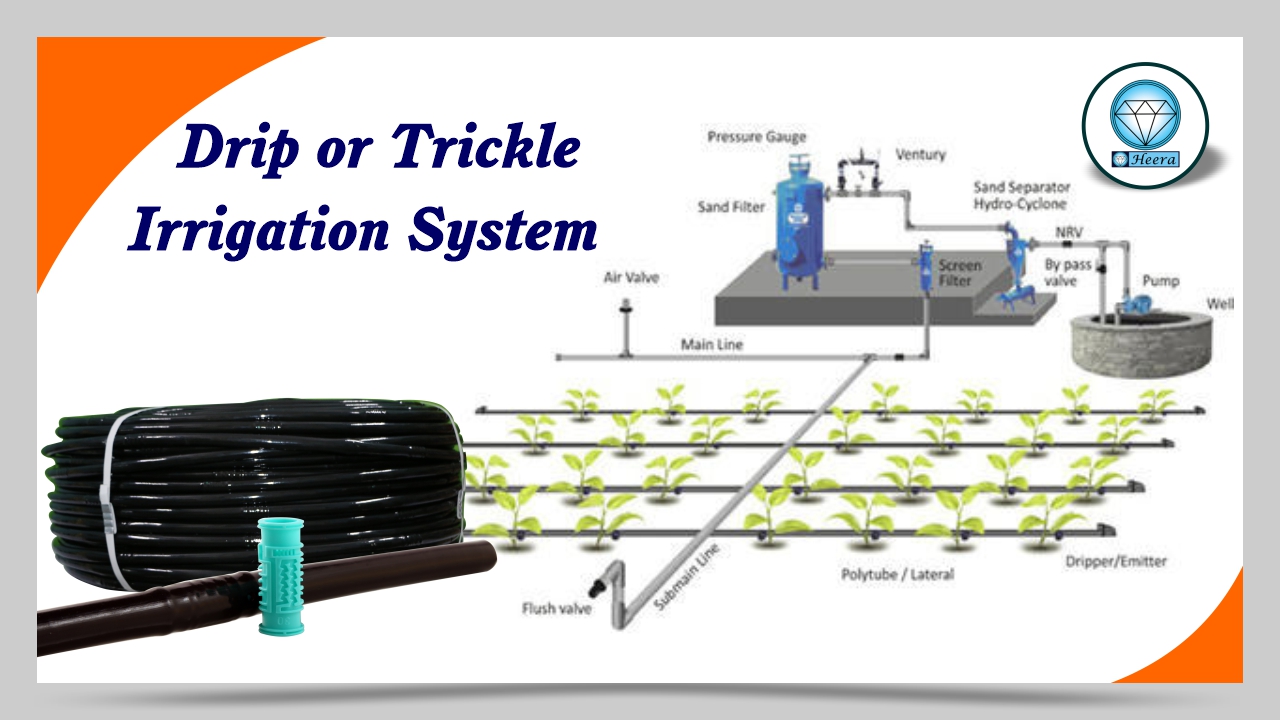No products in the cart.
Return To Shop
Drip or Trickle Irrigation System
What is drip or Trickle irrigation or drip irrigation system?
“Drip irrigation is transforming the lives of millions of farmers across the world, enabling higher yields to be produced from any land, while saving water, fertilizer and energy.”
Drip irrigation is the most efficient water and nutrient delivery system for growing crops. It delivers water and nutrients directly to the Right place – plant’s roots zone, in the Right Amounts, at the right time, so each plant gets exactly what it needs, when it needs it, to grow optimally.
Thanks to drip irrigation, farmers can produce higher yields while saving on water as well as fertilizers, energy and even crop protection products.
How does drip / trickle irrigation work?
Over the years, there have been a number of technological developments in the field of irrigation. Although all irrigation systems provide water to plants, the methods for doing so vary widely.
Surface irrigation techniques involve covering an entire field with water. Overhead irrigation wets the plants but produces runoff. In contrast, Drip Irrigation is a much more controlled irrigation method. It works by exposing the roots to a direct supply of water. This method is facilitated by the use of Drip emitters/ Drippers, which release water in a slow and steady fashion. Drip emitters are small — approximately the size of a quarter — and are located on the ground ( Online Drip ), usually arranged in rows. Drip emitters are connected to a water source by a feeder hose/ Laterals. Another version of drip irrigation uses a hose /Laterals that has drip emitters built into it ( Inline Drip ) . This variation on the drip irrigation technique is called Drip /trickle tape.
The greatest benefit of any type of drip irrigation is the control that these methods provide. In addition, these irrigation techniques are highly economical and precise. For example, the amount of water that a typical sprinkler uses is measured in gallons per minute — the standard sprinkler will emit anywhere between one and five gallons (four to 20 liters) of water per minute. In contrast, the amount of water that a drip emitter uses is measured in gallons per hour. Such a slow flow of water virtually guarantees that it will be absorbed into the ground where it will be used more efficiently and where it won’t evaporate. A well-installed, well-maintained drip-irrigation system all but eliminates the phenomenon of water wastefully running off.
What are the Advantages and Disadvantages of Drip Irrigation? Or the importance of drip irrigation and its limitations :-
The advantages of drip irrigation are:
- Fertilizer and nutrient loss is minimized due to a localized application and reduced leaching.
- Water application efficiency is high if managed correctly.
- Field leveling is not necessary.
- Fields with irregular shapes are easily accommodated.
- Recycled non-potable water can be safely used.
- Moisture within the root zone can be maintained at field capacity.
- Soil type plays a less important role in the frequency of irrigation.
- Soil erosion is lessened.
- Weed growth is lessened.
- Water distribution is highly uniform, controlled by the output of each nozzle.
- Labor cost is less than other irrigation methods.
- Variation in supply can be regulated by regulating the valves and drippers.
- Fertigation can easily be included with minimal waste of fertilizers.
- Foliage remains dry, reducing the risk of disease.
- Usually operated at lower pressure than other types of pressurized irrigation, reducing energy costs.
The disadvantages of drip irrigation are:
- Initial cost can be more than overhead systems.
- The sun can affect the tubes used for drip irrigation, shortening their lifespan.
- The risks of degrading plastic affecting the soil content and food crops. With many types of plastic, when the sun degrades the plastic, causing it to become brittle, the estrogenic chemicals (that is, chemicals replicating female hormones) which would cause the plastic to retain flexibility have been released into the surrounding environment.
- If the water is not properly filtered and the equipment not properly maintained, it can result in clogging or bio clogging.
- For subsurface drip the irrigator cannot see the water that is applied. This may lead to the farmer either applying too much water (low efficiency) or an insufficient amount of water, this is particularly common for those with less experience with drip irrigation.
- Drip irrigation might be unsatisfactory if herbicides or top dressed fertilizers need sprinkler irrigation for activation.
- Drip tape causes extra cleanup costs after harvest. Users need to plan for drip tape winding, disposal, recycling or reuse.
- Waste of water, time and harvest, if not installed properly. These systems require careful study of all the relevant factors like land topography, soil, water, crop and agro-climatic conditions, and suitability of drip irrigation system and its components.
- In lighter soils subsurface drip may be unable to wet the soil surface for germination. Requires careful consideration of the installation depth.
- Most drip systems are designed for high efficiency, meaning little or no leaching fraction. Without sufficient leaching, salts applied with the irrigation water may build up in the root zone, usually at the edge of the wetting pattern. On the other hand, drip irrigation avoids the high capillary potential of traditional surface-applied irrigation, which can draw salt deposits up from deposits below.
- The PVC pipes often suffer from rodent damage, requiring replacement of the entire tube and increasing expenses.
- Drip irrigation systems cannot be used for damage control by night frosts (like in the case of sprinkler irrigation systems)
Why do farmers prefer drip irrigation?
The reason is simple. Drip Irrigation not only delivers greater ROI compared to other of irrigation methods, it also gives farmers an efficient and simple way to operate their farms.
- Higher consistent quality yields
- Huge water savings: no evaporation, no run off, no waste
- 100% land utilization – drip irrigates uniformly in any topography and soil type
- Energy savings: drip irrigation works on low pressure
- Efficient use of fertilizer and crop protection, with no leaching
- Less dependency on weather, greater stability and lower risks
Why do plants prefer drip irrigation?
Just like people, plants like to get their water and nutrients in a balanced way. Nobody wants to eat a month’s worth of food in one day, and the same goes for plants. Which is why drip irrigation applies water and nutrients frequently and in small doses, ensuring optimal growing conditions that helps produce the highest yields possible.
Here’s why plants are more productive with drip irrigation:
- High availability of water and nutrients
- Doses of water and nutrients tailored to plant’s development needs
- No saturation and good soil aeration
- Avoids high salinity caused by excessive fertilizer application
- No wetting of foliage that can result in fungal diseases
- Less competition by weeds
Why the world needs drip irrigation?
By 2050, there’ll be 10 billion people living on our planet, and 20% less arable land per person to grow enough calories. Include increasing water scarcity, and it’s clear why we need a way to increase agricultural productivity and resource efficiency. That’s where drip irrigation fits in, changing the economics of global agriculture by allowing farmers to produce more calories per hectare and cubic meter of water.
- Reduce impact of drought and climate change on food production
- Avoid contamination of ground water and rivers caused by fertilizer leaching
- Support rural communities, reduce poverty, reduce migration to cities
Which crops are suitable for drip irrigation?
Any crop can be grown using drip irrigation. From field crops such as corn soybean or sugarcane, to vegetables and tree crops. Either growing in soil or in a soilless media. On a flat field or on sloping terrain – drip irrigation fits all topographies. The only decision is choosing the right drip configuration based on your crop and field conditions.
How efficient is drip irrigation?
Drip irrigation is known to be the most efficient irrigation methods with 95-100% water use efficiency. This is compared to sprinkler systems that have 80-85% water use efficiency or flood and furrow that are 60-70% efficient. Efficiency is related to the effectiveness of the system on crop performance and eventually on yield and profitability of the farmer.
Is drip irrigation expensive?
Farmers looking to invest in a drip irrigation system should calculate ROI versus alternative irrigation methods. Because drip irrigation delivers significant increases in crop yields while saving on inputs (water, fertilizer, energy and labor), it can pay for itself in a relatively short period of time and give farmers more profit in their pocket.
Why is drip irrigation the best method of watering plants?
Drip irrigation is the best method for watering plants because of its localized watering method.
The plants in your plant bed have root balls that only extend so far. Moisture must be applied to the root balls for the plant to absorb it. There are typically large swaths of mulch with no plants in your plant bed, there is nothing to water here.
So the drip irrigation runs only where water is needed, waters only the bare minimum required, and uses incredibly less water than any alternative sprinkler solution!
Your drip irrigation system is essentially going to water your plants exactly the same way you would if you hand watered your plants with a watering can. Water only going where it needs to.
Compare this to a sprinkler solution. Sprinklers are designed for lawns and cropland where moisture is needed in every square inch.
One Hunter I-20 sprinkler shoots approximately 28-32′ at approximately 45psi. At a 90 degree arc, this sprinkler uses 1.5 gallons of water per minute to water a cone shaped area. At 180 degrees the sprinkler uses 2 gpm.
So let’s say you have a large plant bed. 60′ long. You can install (3) I-20 rotors and use 5 gallons per minute to water your plants.
Or, you can use drip irrigation that uses .6 gph (yes. Gallons per hour) per 100″ of drip line.
So let’s assume we drip circle every plant (most expensive form of drip irrigation). For a 60′ plant bed we are now using almost 250′ of drip line. (Varies based on planting styles, assume single row of plants)
But this drip line will only use 1.5 gallons of water PER HOUR. You can run your drip system for a full hour before you have used the same amount of water as one I-20 will use in 1 minute!
So, localized watering and huge cost savings. That is why drip irrigation is the best for plant beds.
‘ Drip irrigation is a great method to water with for several reasons. First you have consistency in watering, especially when you put the system on a timer. This is important to the growth of a lot of vegetables. Second, it conserves water because the plants get a slow steady stream of water which soaks their roots. This will minimize evaporation. ’
-
Product on sale
 HEERA PIPE MASTER FLEX₹2,500.00 – ₹3,600.00
HEERA PIPE MASTER FLEX₹2,500.00 – ₹3,600.00 -
 Heera Fertilizer Tank₹4,800.00 – ₹5,000.00
Heera Fertilizer Tank₹4,800.00 – ₹5,000.00 -
 HEERA EASY TO FIT SET₹3,800.00 – ₹4,500.00
HEERA EASY TO FIT SET₹3,800.00 – ₹4,500.00 -
 HEERA PIPE MASTER HIGH PRESSURE₹3,200.00
HEERA PIPE MASTER HIGH PRESSURE₹3,200.00 -
 Heera Flat Inline Drip Package For 1 Acre (Package of 10500)₹8,835.00
Heera Flat Inline Drip Package For 1 Acre (Package of 10500)₹8,835.00 -
 Krishi Pipe₹720.00 – ₹900.00
Krishi Pipe₹720.00 – ₹900.00 -
 Heera Online Drip Lateral₹1,550.00 – ₹2,400.00
Heera Online Drip Lateral₹1,550.00 – ₹2,400.00 -
 Heera Inline Drip Lateral₹1,250.00 – ₹1,850.00
Heera Inline Drip Lateral₹1,250.00 – ₹1,850.00 -
 Heera Nano / Tiny₹750.00
Heera Nano / Tiny₹750.00

















Leave a reply